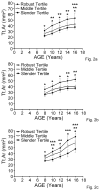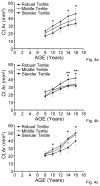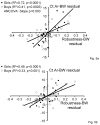Variation in childhood skeletal robustness is an important determinant of cortical area in young adults
- PMID: 21810492
- PMCID: PMC3167032
- DOI: 10.1016/j.bone.2011.07.018
Variation in childhood skeletal robustness is an important determinant of cortical area in young adults
Abstract
A better understanding of bone growth will benefit efforts to reduce fracture incidence, because variation in elderly bone traits is determined primarily by adulthood. The natural variation in robustness was used as a model to understand how variable growth patterns define adult bone morphology. Longitudinally acquired hand radiographs of 29 boys and 30 girls were obtained from the Bolton-Brush study for 6 time points spanning 8 to 18 years of age. Segregating individuals into tertiles based on robustness revealed that the biological activity underlying bone growth varied significantly with the natural variation in robustness. For boys, slender metacarpals used an osteoblast-dependent growth pattern to establish function, whereas robust metacarpals used an osteoclast-dependent growth pattern. In contrast, differences in biological activity between girls with slender and robust metacarpals were largely based on the age at which the marrow surface changed from expansion to infilling. Importantly, cortical area for slender metacarpals was as much as 19.7% and 32.2% lower than robust metacarpals for boys and girls, respectively, indicating that robustness was a major determinant of adult cortical area. Finally, after accounting for robustness and body weight effects, we found that the inter-individual variation in cortical area was established as early as 8 years of age. While variation in the amount of bone acquired during growth has primarily been attributed to factors like nutrition, exercise, and genetic background, we showed that the natural variation in robustness was also a major determinant of cortical area, which is an important determinant of bone mass. This predictable relationship between robustness and cortical area should be incorporated into clinical diagnostic measures and experimental studies.
Copyright © 2011 Elsevier Inc. All rights reserved.
Conflict of interest statement
Figures











References
-
- Aeberli D, Eser P, Bonel H, Widmer J, Caliezi G, Varisco PA, Moller B, Villiger PM. Reduced trabecular bone mineral density and cortical thickness accompanied by increased outer bone circumference in metacarpal bone of rheumatoid arthritis patients: a cross-sectional study. Arthritis Res Ther. 2010;12:R119. - PMC - PubMed
-
- Albright F, Smith PH, Richardson AM. Post-menopausal osteoporosis. Its clinical features. JAMA. 1941;116:2465–2474.
-
- Barnett NBE. The clinical and radiological problem of thin bones. Br J Radiol. 1961;34:683–92. - PubMed
-
- Binkley TL, Berry R, Specker BL. Methods for measurement of pediatric bone. Rev Endocr Metab Disord. 2008;9:95–106. - PubMed
-
- Bradney M, Pearce G, Naughton G, Sullivan C, Bass S, Beck T, Carlson J, Seeman E. Moderate exercise during growth in prepubertal boys: changes in bone mass, size, volumetric density, and bone strength: a controlled prospective study. J Bone Miner Res. 1998;13:1814–21. - PubMed
Publication types
MeSH terms
Grants and funding
LinkOut - more resources
Full Text Sources

